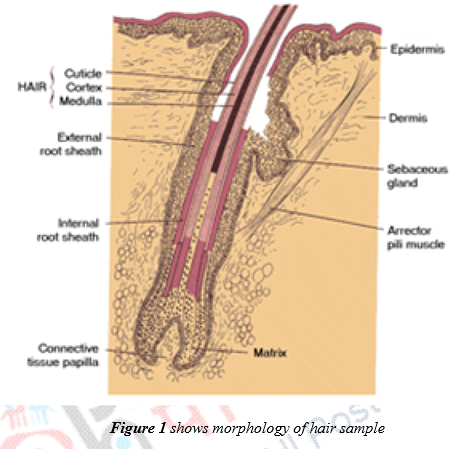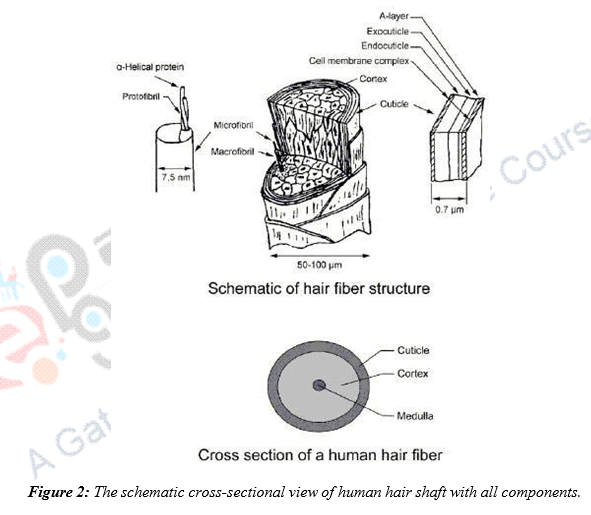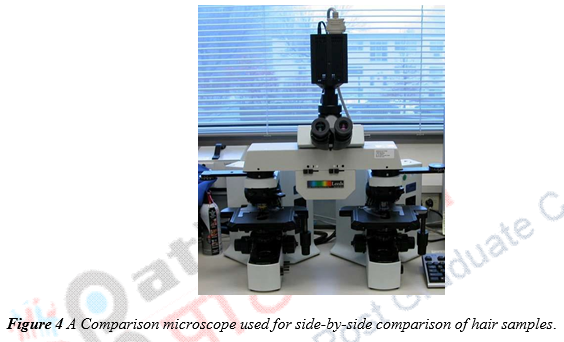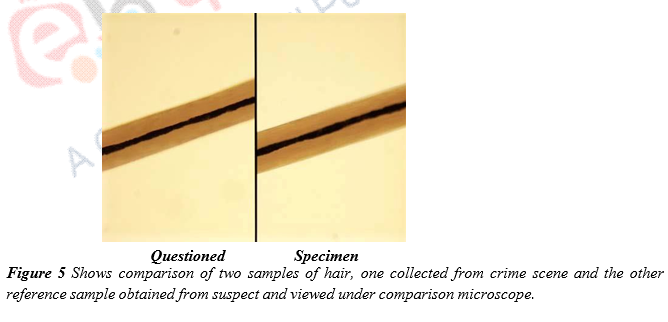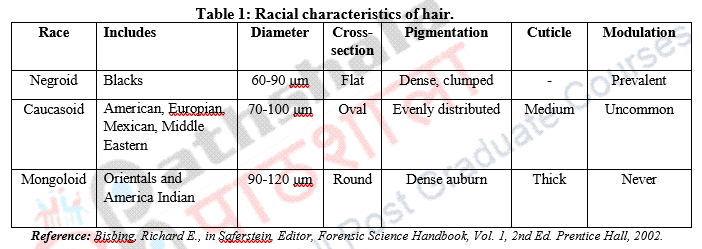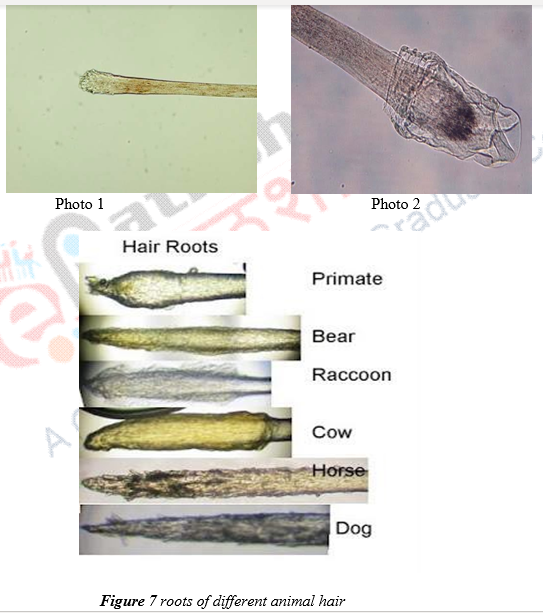24 Structural Polymorphism of Human Hair
25.1 Preface
This module deals with the examination of hair. Hair examination has been used as one of the most popular identification measures because of its high comparability, immutability and inertness. Therefore, a detailed examination of hair is very important forensically to establish identity of the accused in criminal cases. Hair analysis reveals the very nature of hair, its origin as to human or non- human hair and polymorphism.
The hair can be analyzed by determining the chemical makeup of the hair or extracting DNA from the hair follicle. Hair can also be analyzed through the use of a microscope or by simply comparing two or more hair against one another. This process can be done for a number of reasons, including drug testing, paternity testing, medical testing, or even for the purpose of solving a crime. The ability to analyze hair is extremely important in the field of forensic science, as it can answer questions that no other evidence may be able to. For instance, if a person was poisoned, traces of the poison may be found within hair samples long after the poison has left organs within the body. This is especially true in case of arsenic poisoning. Hair analysis is also a very helpful process in locating and eliminating suspects in crimes. Crime scene investigators are usually responsible for collecting hair samples at crime scenes to be analyzed later with the hopes of solving a crime.
While a hair sample alone may not be enough to solve a case, it is often a good place to start and finish. Hair samples can give an excellent lead in an investigation, as they can tell investigators a hair colour, a specific race, whether or not the hair has been dyed, plucked or naturally fallen hair, and, in some cases, a particular hair style. These matters may not seem important when it comes to crime, but it often helps investigators develop an idea of the basic features of a suspect. At the end of an investigation, it can also be very useful as further evidence to confirm or deny that a particular individual was at a crime scene. With hair analysis in forensic science, it would be better to answer many questions, as there may be dearth of other solid scientific proof.
25.1 Learning Outcomes
In this module, we shall be focusing on the importance of one of the most important evidence in personal identification i.e; hair. The students will learn basic types of human hair like lanugo, vellus and terminal hair. How they are formed and how they differentiate from animal hair and how should they be collected from different sites. Students will learn how to search for, collect and prepare them for further comparison and analysis in this module.
25.2 Introduction
Hair is a characteristic of mammalian skin. For some animals it serves as a warm coating of thick hair to protect them from harsh weather and hazards of environment, or to camouflage them as protection from attacks by their predators. Human too have a fine layer of hair covering the entire body except palms and soles. Hair analysis is the process by which hair is analyzed to find out things about the person it has come from. In hair analysis, generally, the more hair that is available for analysis, the better the results will be. Typically, the best samples for analysis include somewhere around 50 strands of hair. This sounds like a lot of hair but most investigators do not get that much hair from scene of crime. The best results are also often received when the hair strands are taken from the back of the head versus the sides or the front. Hair is an example of trace evidence that can be left at a crime scene or removed from a crime scene (Locard’s exchange principle). Although the hair shaft is not unique to a specific person, it can be used to identify a class of individuals. Therefore, crime scene technicians collect any hair that they find and send them to the lab for analysis.
Hair, which is composed primarily of the protein keratin, can be defined as slender outgrowths of the skin of mammals. Each species of animal possesses hair with characteristic length, colour, shape, root appearance, and internal microscopic features that distinguish one animal from another. Considerable variability also exists in the types of hair that are found on the body of an animal. In human, hair found on the head, pubic region, arms, legs, and other body areas have characteristics that can determine their origin. On animals, hair types include coarse outer hair or guard hair, the finer fur hair, tactile hair such as whiskers, and other hair that originate from the tail and mane of an animal.
Their presence may associate a suspect to a crime scene or victim, because hair can be transferred during physical contact. The types of hair recovered and the condition and number of hair found all impact on their value as evidence in a criminal investigation. Comparisons of the microscopic characteristics of questioned hair to known hair samples help determine whether a transfer may have occurred.
25.1.1 Components of hair
The hair is the major component of hair follicle commonly examined microscopically in forensic hair comparison. It is a long thin cylinder of keratinised cells and usually has three distinct cellular components:
1. Medulla- a central or core portion running along the central axis.
2. Cortex- the main component filling the inside of each hair shaft.
3. Cuticle- the main outer covering.
1. Medulla
It is formed as a column of cells that produce a protein that is distinct from the proteins of the cortex and cuticle in that it contains the amino acids. Human hair is unique in that its medullary index (the fraction of the hair shaft’s diameter that the medulla occupies) is very small: generally less than 1/3. Other species will have ratios much larger, usually at least 1/2. The medulla’s presence in human hair and the patterns of which differ both from person to person and from strand to strand on a single person’s head. One hair may have absence of medulla while another from the same person may have a complete or fragmented medulla. For this reason, medulla patterns are not very useful as forensic evidence and are typically only used for determining the species of the subject. The medulla contains large amounts of mitochondrial (as opposed to nuclear) DNA. Mitochondrial DNA is passed from the mother to her offspring. As such, mDNA may be of forensic value.
2. Cortex
The cortex of the hair shaft is located between the hair cuticle and medulla and is the thickest hair layer. It also contains most of the hair’s pigment, giving the hair its colour. The pigment in the cortex is melanin, which is also found in skin. The distribution of this pigment varies from animal to animal and person to person. The cortex determines the colour, flexibility and tensile strength of the hair strand. Tensile strength is the maximum amount of force the strand of hair can take in a longitudinal direction without breaking.
3. Cuticle
The hair cuticle is the outermost part of the hair shaft. It is a hard shingle-like layer of overlapping cells. It is formed from dead cells which form scales that give the hair shaft strength and do the best job of providing protection for it. The hair cuticle is the first line of defence against all forms of damage; it acts as a protective barrier for the softer inner structure including the medulla and cortex. The cuticle is responsible for much of the mechanical strength of the hair fibre. A healthy cuticle is more than just a protective layer, as the cuticle also represents the structure that controls the water content of the fibre. Much of the shine that makes healthy hair so attractive is due to the cuticle. Cuticles are often damaged by excessive mechanical manipulation such as brushing, heat (using curling irons), chemical processing, harmful UV sun-rays or dust and wind etc. can cause wear and tear on hair and damage the hair cuticles. Also cuticle cells may be elongate, tapering to a point, ovate or most often flattened.
25.3 Stages of hair
There are three stages of hair growth and replacement, these are as follows:
- Anagen
- Catagen
- Telogen
The hair follicle is a dynamic organ in which division, differentiation and migration of cells occur in the various tissues of which it is composed. These processes give rise to the growth of hair fiber, which is formed as the result of the biosynthesis and hardening of the contents of medulla, cortex and cuticle cells of the hair shaft. This growth, however, is not a continuous process, but one which ceases periodically and then starts again, to be repeated in what is known as the hair growth cycle. The stage of this cycle in which hair grows actively is called Anagen. It is when the follicle is full size and is maximally biochemically active. This is followed by a quiescent or regression phase called as Catagen, when metabolic activity and hair growth slows down and eventually stops at stage called Telogen or resting phase. It becomes dead and falls off on its own.
25.4 Types of human hair
Head and body hair of humans is classified as intermediate hair combining the characteristics of bristle and wool hair.
Four types of hair appear on the bodies of humans:
1. Primordial hair
It appears as early as the 3rd month of gestation, growing on the upper lip, the eyebrows, the palms and soles of the fetus. They gradually disappear and are replaced by softer lanugo hair over the entire body.
2. Lanugo hair
It is the special downy hair that completely covers the human baby inside the womb. It is like fur, but before the fetus is born the lanugo hair is replaced by vellus hair. These are normally shed after the 6th month of gestation. They are fine, soft, unmedullated, and normally unpigmented hair. The surface of lanugo hair is smooth with almost indiscriminate scales. It is replaced by vellus and terminal hair. Lanugo hair is often observed on an aborted fetus and can be useful in investigation of possible infanticide.
3. Vellus hair
These are frequently short, fine, colourless hair found all over the body. Vellus hair helps to regulate body temperature. Vellus hair replaces lanugo hair on a human fetus at 36 to 40 weeks of gestation. The growth cycle of vellus hair is different from the growth cycle of terminal hair. At puberty, the androgen hormone causes much of the vellus hair to turn into terminal hair and stimulates the growth of new hair in the armpit and the pubic area. In men, this change in vellus hair occurs on the face and the body. Vellus hair grows individually or in small patches of varying, and sometimes irregular, length of 2–4 cm. These irregularities are governed by genetics, and often persist throughout a lifetime. This kind of hair growth is usually not harmful.
4. Terminal hair
It is the type of natural hair to which most people refer in their everyday lives. It is the type of hair that grows on your head, in your pubic regions and on almost all parts of your body. A hormone called androgen controls this body hair, also known as androgenic hair.
There are three types of hair usually seen in animals, they are:
1. Vibrissa
These are the whiskers of many animals. They are normally tactile and sensitive, such as the whiskers on a cat.
2. Bristle
This is the coarse bristle that provides an animal with a protective coat. These guard hair can readily be identified by their distinctive appearance and morphology between various animal families.
3. Wool
Wool or fur provides insulation from wet and cold. These fine hair covers the bodies of all mammals.
25.5 Hair analysis
Hair is a common type of evidence submitted to the trace section for analysis. On average, human shed approximately 100 head hair per day. Because we are continuously shedding hair, forensic analysis of hair is beneficial to the establishment of associations between individuals, a person and an environment, etc. (Example: a questioned hair from a victim’s jeans is examined and found to be consistent with the suspect’s hair. This examination has provided evidence that an association may have occurred between the suspect and the victim).
A hair is a fibrous outgrowth from the skin of mammals and consists of three anatomical regions, the cuticle, medulla and cortex. Characteristics within these regions are used to determine whether the hair is of human or animal, racial origin and body area. A microscopic hair examination can also determine if a hair was forcibly removed, artificially treated or diseased. A comparison microscope can be used to compare a questioned hair to a known hair sample in order to determine if the hair are similar and if they could have come from a common source. A questioned hair and known hair sample are viewed, side-by-side, using a comparison microscope in order to determine if they have similar characteristics.
25.5.1 Colour
The first step of hair analysis is to compare the hair colour of questioned hair with that of suspect’s hair samples. Hair colour could be naturally different in two individuals of same race, geographic area and sharing same gene pool or sometimes differ in colour when one would have dyed or coloured the hair. In either case, it brings out specific points of difference in forensic case work investigations. For this purpose, the forensic expert needs to compare minimum of 20-40 strands of hair samples obtained from scene of crime with that procured from specimens. The expert matches the colour of air dried hair with the literature of SOP colour card and ticks on the column of colour that best matches hair colour.
He also needs to mention whether the hair were dyed previously or not. Once this preliminary investigation is done and yields positive result, he may further inspect the hair shaft microscopically for more detailed morphological analysis.
25.5.2 Race
The hair evidence is most suited in cases of sexual assaults, hit-n-run, murders and child abuse cases. The expert needs to look for the presence of root of the hair strand. If it is absent or dead, it is a naturally fallen hair whereas in case of plucked hair, if the root is present and bulbous then DNA may be isolated. Once DNA is extracted, one can say about the sex of the owner of hair, race of the bearer and if he/ she suffering from any disease or poisoning also can be told.
Examination of Common Hair Features in a Wet Mount Slide
- Pull out (don’t cut) one strand of suspect’s hair.
- Place the hair on a microscope slide.
- Add a drop of water and place a cover slip on top.
- On high power, scan the entire length of the hair shaft. Determine the type of medulla sketch and label the features.
- Use the camera to take a picture of hair through the microscope lens.
- Find the root end. Make a sketch of what you see.
25.5.3 Specie of Origin
For specie origin from hair, medullary index is predominantly studied along with other tests for specie origin such as pigment distribution, scale patterns etc. Medullary index is calculated as the diameter of the medulla/ total diameter of hair shaft cross-section. If the value comes 1/3 or less it is human hair while if it is 1/2 or more it a non-human hair.
There can be 4 different types of medulla in humans, they are:
- Continuous
- Fragmented
- Discrete
- Absent
Examination of Common Hair Features in a Prepared Slide
1. Obtain a prepared slide of human hair along with two different animal hair slides.
2. View under the compound light microscope, first at low power and then at higher powers. Choose a representative hair on each slide.
3. Scan the entire length of the hair. Determine the type of medulla if the hair is human, or medulla type and pattern if the hair is animal.
4. Sketch the features of the one representative hair from each slide include labels for the medulla, cortex, and cuticle. Your drawing should be large and detailed. Include the magnification used (actual magnification number, not low/medium/high.)
Examination of Cuticle Scale Patterns
1. Paint a thin coat of clear nail polish on a glass slide. Cover an area about 1/2cm x 2cm.
2. Gently embed the shaft of a hair into the nail polish. Leave the root and tip ends free of the polish.
3. Before the polish has thoroughly dried, but after the surface becomes partially solidified (approximately 1 minute), grab onto the root and tip end of the hair with two hands and lift the hair straight up off the slide. You should now see an imprint of the hair in the polish.
4. Observe under the microscope and make a sketch of the cuticle scale pattern.
5. Use the camera to take a picture of the hair cuticle scale pattern through the microscope lens. Repeat steps 1-4 with 1 of the animal hair samples and make a sketch of the cuticle.
25.5.4 Polymorphism
a. Polymorphism of hair was considered in terms of their origin in mammalian evolution. Although forensic analysis of STR profiles is a well established technique and has proved invaluable in linking individuals to crime scenes, such profiles can give only limited information about the likely appearance of an individual. Therefore, in circumstances where there is no eyewitness evidence of a crime and a biological sample has been left at the crime scene by an unknown individual, it would obviously be of benefit to establish some indication of that person’s physical characteristics, such as the colour of the hair.
Variation in human hair and skin colour is caused by differences in the distribution, level and type of the pigment melanin which is produced in specialised cells known as melanocytes. Melanin exists as two distinct compounds: eumelanin which is brown/black in colour and phaeomelanin which is red/yellow. Although human pigmentation shows a wide variety of phenotypes and is thought to be under the control of several genetic loci, recent work has shown that in many cases the red hair phenotype can be associated with variants of a single gene, the melanocortin-1 receptor (MC1R) or melanocyte stimulating hormone receptor. Red hair contains higher levels of phaeomelanin than hair of other colours. Certain variants of the MC1R have also been associated with different populations, in particular it has been reported that one variant (Arg163Glu) is more common in Chinese and Southeast Asian individuals than Caucasians, Africans or Indians. It has been reported that red hair appears to be inherited in a recessive fashion in many families requiring an individual to be homozygous for a given variant of the gene or compound heterozygous for two different variants in order for red hair to result.
Vibrissae significantly differ from hair by the structure. Apparently, they originated from mechanoreceptors of Cotylosauria and developed only in the Theriodontia-Cynodontia-Panthotheria- Theria lineage (Metatheria, Eutheria). No vibrissa developed in the lineage of Theriodontia- Cynodontia-Prototheria (Multituberculata, Triconodonta, Monotremata), where mechanoreceptors or glandular structures of amphibian ancestors transformed into electro-and mechanoreceptors. Hair originated in these lineages in parallel from keratin epidermis in correlation with the establishment of homeothermy but independently of vibrissae. Wide and active adaptive radiation provided for a strong differentiation of hair largely similar in different taxa. Spines originated by heterochrony of hair generations.
b. Hair suitability for DNA examinations
Nuclear DNA analysis can be done on human hair. The trace section assists the DNA section by screening hair and determining their suitability for DNA testing. A microscope is used to examine the root end of the hair, in order to determine if they are suitable. The hair in photo 1 is not suitable for nuclear DNA analysis and the hair in photo 2 is suitable.
If a hair is deemed not suitable for nuclear DNA analysis (e.g. no root present or no tissue is attached), it can be sent for mitochondrial DNA testing. A root does not have to be present in order for a hair to be suitable for mitochondrial DNA testing.
c. Structural polymorphism of human hair
Hair keratin-associated proteins (KAP) are a major structural component of the hair fiber. In humans, five clusters of KAP genes have been identified, leading to the isolation of more than 80 individual KAP members. Of these, a cluster of high/ultrahigh sulfur KAP has been characterized on chromosome 17q12-21. Within this cluster, however, there was an incompletely sequenced region in which the ultrahigh sulfur KAP4 genes were located. A recently reported human bacterial artificial chromosome clone, AC100808, finally covered the gap, which enabled us to characterize the complete set of KAP4 genes in this cluster. Analysis of the nucleotide sequences of AC100808, together with PCR amplification, allowed us to identify numerous size polymorphisms in the KAP4 genes, which were mainly due to variations in the sequences encoding cysteine-rich repeat segments. Taken together, the data indicate that the polymorphic alleles of the KAP4 genes may have arisen through intragenic deletion and/or duplication of sequences encoding the repeat structures during evolution.
25.4 Summary
Hair can be important physical evidence at the crime scene. Hair normally falls from the body over the course of a day. It will stick to a number of materials, especially fabric and clothing. Hair is not easily destroyed, even with exposure to moisture and decomposition of accompanying tissue.
| you can view video on Structural Polymorphism of Human Hair |

